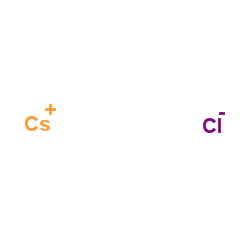7647-17-8
| Name | caesium chloride |
|---|---|
| Synonyms |
EINECS 231-600-2
cesium,chloride MFCD00010955 Cesium chloride |
| Description | Cesium chloride is a blocker of potassium channel. Cesium chloride prevents the decrease of Na+ transport produced by Alloxan[1][2]. Cesium chloride has induced cardiac arrhythmias, including torsade de pointes in animal models[3]. |
|---|---|
| Related Catalog | |
| In Vitro | Cesium chloride (CsCl) decreases the increment of membrane potential, the elevation of intracellular calcium and the upregulation of NOS, ET-1 and VEGF expressions, which are induced by Acrolein[3]. |
| In Vivo | Cesium Chloride (12 mg/100 g body weight, daily for 30 days; i.p.; male Wistar rats- BOO model) could significantly weaken the effect of XJT (traditional Chinese medicine) on not only the expression of these potassium channels but also the bladder weight, urodynamics, and oxidative stress[1]. |
| References |
| Density | 3.983 |
|---|---|
| Boiling Point | 1290 °C |
| Melting Point | 645 °C(lit.) |
| Molecular Formula | CsCl |
| Molecular Weight | 168.359 |
| Flash Point | 1303°C |
| Exact Mass | 167.874298 |
| Index of Refraction | 1.6418 |
| Stability | Stable. Deliquescent. Incompatible with strong oxidizing agents, strong acids. Protect from moisture. |
| Water Solubility | 1860 g/L (20 ºC) |
CHEMICAL IDENTIFICATION
HEALTH HAZARD DATAACUTE TOXICITY DATA
MUTATION DATA
|
| Symbol |

GHS08 |
|---|---|
| Signal Word | Warning |
| Hazard Statements | H361 |
| Precautionary Statements | P280 |
| Personal Protective Equipment | Eyeshields;Gloves;type N95 (US);type P1 (EN143) respirator filter |
| Hazard Codes | Xn:Harmful |
| Risk Phrases | R68 |
| Safety Phrases | S36/37-S26 |
| RIDADR | 2923 |
| WGK Germany | 2 |
| RTECS | FK9625000 |
| HS Code | 28273980 |
| HS Code | 28273980 |
|---|


